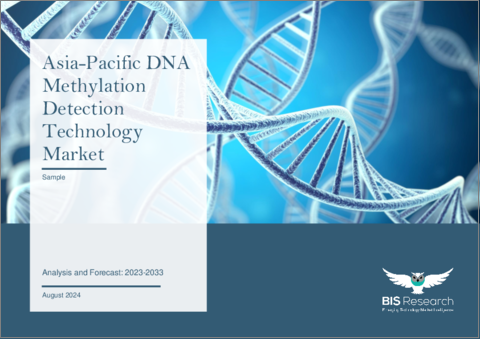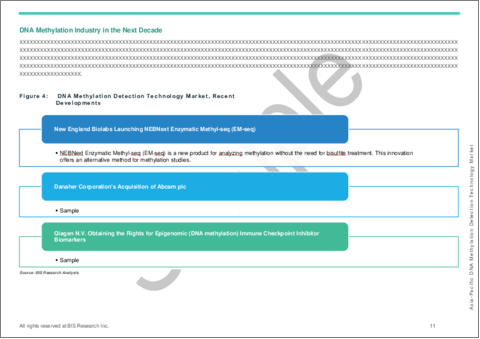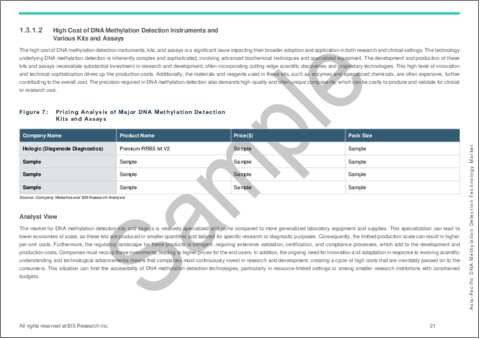|
|
市場調査レポート
商品コード
1556452
アジア太平洋のDNAメチル化検出技術市場:分析と予測(2023年~2033年)Asia-Pacific DNA Methylation Detection Technology Market: Analysis and Forecast, 2023-2033 |
||||||
カスタマイズ可能
|
|||||||
| アジア太平洋のDNAメチル化検出技術市場:分析と予測(2023年~2033年) |
|
出版日: 2024年09月18日
発行: BIS Research
ページ情報: 英文 58 Pages
納期: 1~5営業日
|
全表示
- 概要
- 図表
- 目次
アジア太平洋のDNAメチル化検出技術の市場規模は、2023年に4億4,360万米ドルとなりました。
同市場は、2023年から2033年にかけて17.79%のCAGRで拡大し、2033年には22億8,060万米ドルに達すると予測されています。この成長は、バイオテクノロジーおよび製薬業界における新興企業の増加、学術機関間の共同研究の増加、エピジェネティックバイオマーカーとしてのDNAメチル化検出技術の利用拡大が要因と考えられます。同市場は、さまざまなツール、ソフトウェア、消耗品を提供しています。
| 主要市場統計 | |
|---|---|
| 予測期間 | 2023年~2033年 |
| 2023年の評価 | 4億4,360万米ドル |
| 2033年の予測 | 22億8,060万米ドル |
| CAGR | 17.79% |
アジア太平洋におけるDNAメチル化検出技術市場は、個別化医療に対する需要の高まりとこの分野における最先端のゲノム研究により急速に拡大しています。がん、神経疾患、心血管疾患など多くの疾患に関連する重要なエピジェネティック修飾のひとつがDNAメチル化です。DNAメチル化は遺伝子発現の制御に不可欠です。疾患の診断や治療におけるエピジェネティクスの役割がますます明らかになるにつれ、正確で効果的なDNAメチル化検出技術がますます求められるようになっています。
特に韓国、中国、日本のような国では、公的部門と商業部門の両方が精密医療とゲノミクスに関連する取り組みに多額の資金を提供しています。さらに、この地域の慢性疾患率の高さは、早期発見と標的治療に対する需要を高め、DNAメチル化技術の採用をさらに後押ししています。
DNAメチル化解析の精度とスピードは、次世代シーケンシング(NGS)やハイスループットプラットフォームのような技術開発によって向上しており、これらの技術は学術機関や医療専門家にとってより手頃な価格にもなっています。DNAメチル化検出技術の市場は、アジア太平洋が生物医学革新の中心地としての地位を確立するにつれて大きく成長すると予想されます。これは、個別化医療の進展と患者の予後改善にとって極めて重要です。
当レポートでは、アジア太平洋のDNAメチル化検出技術市場について調査し、市場の概要とともに、地域別の動向、および市場に参入する企業のプロファイルなどを提供しています。
目次
エグゼクティブサマリー
第1章 市場
- 動向:現在および将来の影響評価
- サプライチェーンの概要
- 研究開発レビュー
- 規制状況
- 主要な世界的出来事の影響分析-COVID-19
- 市場力学の概要
第2章 地域
- 地域別概要
- 促進要因と抑制要因
- アジア太平洋
第3章 市場-競合ベンチマーキングと企業プロファイル
- 今後の見通し
- 地理的評価
- Takara Bio Inc.
第4章 調査手法
List of Figures
- Figure 1: DNA Methylation Detection Technology Market (by Region), $Billion, 2022, 2026, and 2033
- Figure 2: Number of Methylation Analysis Publications, in Thousands, 2002-2020
- Figure 3: Number of Commercially Available Methylation Tests (by Application Areas)
- Figure 4: DNA Methylation Detection Technology Market, Recent Developments
- Figure 5: Supply Chain and Risks within the Supply Chain
- Figure 6: DNA Methylation Detection Technology Market (by Country), January 2021-December 2023
- Figure 7: DNA Methylation Detection Technology Market (by Year), January 2021-December 2023
- Figure 8: Impact of COVID-19 on DNA Methylation Detection Technology
- Figure 9: Impact Analysis of Market Navigating Factors, 2022-2033
- Figure 10: Advantage of DNA Methylation as Epigenetic Biomarkers
- Figure 11: Analyzing the Differences: IColocomf vs. FIT and Colonoscopy
- Figure 12: Evolution in Next-Generation Sequencing (NGS)Techniques for DNA Methylation Analysis, 2005-2021
- Figure 13: Factors Responsible for Complexity in Data Interpretation
- Figure 14: Pricing Analysis of Major DNA Methylation Detection Kits and Assays
- Figure 15: Startups Working in Epigenomics Research
- Figure 16: China DNA Methylation Detection Technology Market, $Million, 2022-2033
- Figure 17: Japan DNA Methylation Detection Technology Market, $Million, 2022-2033
- Figure 18: Australia DNA Methylation Detection Technology Market, $Million, 2022-2033
- Figure 19: South Korea DNA Methylation Detection Technology Market, $Million, 2022-2033
- Figure 20: Rest-of-Asia-Pacific DNA Methylation Detection Technology Market, $Million, 2022-2033
- Figure 21: Strategic Initiatives, 2019-2023
- Figure 22: Share of Strategic Initiatives, 2019-2023
- Figure 23: Data Triangulation
- Figure 24: Top-Down and Bottom-Up Approach
- Figure 25: Assumptions and Limitations
List of Tables
- Table 1: Market Snapshot
- Table 2: DNA Methylation Detection Technology Market, Opportunities
- Table 3: Market Share of Key Companies, 2022
- Table 4: DNA Methylation Detection Technology Market, Product Benchmarking
- Table 5: Examples of Increasing Research in the DNA Methylation Detection Technology Industry
- Table 6: Key Companies and Technological Advancements, 2019-2023
- Table 7: DNA Methylation Detection Technology Market (by Region), $Million, 2022-2033
- Table 8: India DNA Methylation Detection Technology Market, $Million, 2022-2033
- Table 9: Company Market Share, 2022
Introduction to Asia-Pacific (APAC) DNA Methylation Detection Technology Market
The Asia-Pacific DNA methylation detection technology market was valued at $443.6 million in 2023 and is expected to reach $2,280.6 million by 2033, growing at a CAGR of 17.79% between 2023 and 2033. This growth can be ascribed to rising startups in the biotechnology and pharmaceutical industries, growing collaborations between academic institutions, and the growing use of DNA methylation detection technology as epigenetic biomarkers. The market offers a range of tools, software, and consumables.
Market Introduction
| KEY MARKET STATISTICS | |
|---|---|
| Forecast Period | 2023 - 2033 |
| 2023 Evaluation | $443.6 Million |
| 2033 Forecast | $2,280.6 Million |
| CAGR | 17.79% |
The market for DNA methylation detection technologies in Asia-Pacific is expanding rapidly due to the rising demand for personalized medicine and cutting-edge genomic research in the area. One important epigenetic modification that is linked to a number of diseases, including cancer, neurological disorders, and cardiovascular conditions, is DNA methylation. It is essential for regulating gene expression. Accurate and effective DNA methylation detection technologies are becoming more and more in demand as the role of epigenetics in disease diagnosis and treatment becomes increasingly clear.
Growing investments in biomedical research are driving the market's growth, especially in nations like South Korea, China, and Japan where both the public and commercial sectors are heavily funding efforts related to precision medicine and genomics. Furthermore, the region's high rate of chronic illnesses is increasing the demand for early detection and targeted therapies, further boosting the adoption of DNA methylation technologies.
The precision and speed of DNA methylation analysis are being improved by technological developments like next-generation sequencing (NGS) and high-throughput platforms, which are also making these technologies more affordable for academic institutions and medical professionals. The market for DNA methylation detection technology is expected to grow significantly as APAC establishes itself as a center for biomedical innovation. This will be crucial for the advancement of personalized medicine and better patient outcomes.
Market Segmentation
Segmentation 1: by Contry
- China
- Japan
- India
- Australia
- South Korea
- Rest-of-Asia-Pacific
How can this report add value to an organization?
Growth/Marketing Strategy: A strategic growth and marketing approach for the APAC DNA methylation detection technology market would involve positioning the company as a leader in innovative solutions that address the evolving needs of researchers, clinicians, and pharmaceutical partners. This would entail leveraging technological advancements to develop cutting-edge products with enhanced sensitivity, specificity, and scalability while also investing in comprehensive customer support, training programs, and collaborative partnerships to foster customer loyalty and drive market penetration. Furthermore, targeted marketing campaigns highlighting the clinical relevance, cost-effectiveness, and competitive advantages of the company's offerings would help to increase brand visibility, attract new customers, and expand market share in this rapidly growing and dynamic industry.
Competitive Strategy: Key players in the APAC DNA methylation detection technology market have been focusing on innovation, differentiation, and strategic collaborations to gain a competitive edge. By investing in research and development, companies can develop novel detection methods, improve assay sensitivity, and expand application areas. Differentiation through the development of proprietary technologies, customizable solutions, and value-added services can help companies stand out in a crowded market, strengthen market positions, acquire new technologies, and broaden product portfolios.
Table of Contents
Executive Summary
Scope and Definition
1 Markets
- 1.1 Trends: Current and Future Impact Assessment
- 1.1.1 Key Trends
- 1.1.2 Bisulfite Conversion as a Gold Standard in the DNA Methylation Detection Technology Market
- 1.1.3 Expansion of DNA Methylation Detection Technology in Clinical Research Applications
- 1.2 Supply Chain Overview
- 1.2.1 Value Chain Analysis
- 1.2.2 Market Map
- 1.3 Research and Development Review
- 1.3.1 Patent Filing Trend (by Country, Company)
- 1.4 Regulatory Landscape
- 1.5 Impact Analysis for Key Global Events - COVID-19
- 1.6 Market Dynamics Overview
- 1.6.1 Market Drivers
- 1.6.1.1 Increasing Adoption of DNA Methylation Detection Technology as Epigenetic Biomarkers
- 1.6.1.2 Increasing Research and Development in Genomics and Epigenetics
- 1.6.1.3 Technological Advancements in Detection Methods
- 1.6.2 Market Restraints
- 1.6.2.1 Complexity in Data Interpretation of DNA Methylation Data
- 1.6.2.2 High Cost of DNA Methylation Detection Instruments and Various Kits and Assays
- 1.6.3 Market Opportunities
- 1.6.3.1 DNA Methylation Detection Technology as an Early Disease Diagnostic Tool
- 1.6.3.2 Expansion of DNA Methylation Detection in Emerging Geographies
- 1.6.1 Market Drivers
2 Regions
- 2.1 Regional Summary
- 2.2 Drivers and Restraints
- 2.3 Asia-Pacific
- 2.3.1 Regional Overview
- 2.3.2 Driving Factors for Market Growth
- 2.3.3 Factors Challenging the Market
- 2.3.4 China
- 2.3.5 Japan
- 2.3.6 India
- 2.3.7 Australia
- 2.3.8 South Korea
- 2.3.9 Rest-of-Asia-Pacific
3 Markets - Competitive Benchmarking & Company Profiles
- 3.1 Next Frontiers
- 3.2 Geographic Assessment
- 3.2.1 Takara Bio Inc.
- 3.2.1.1 Overview
- 3.2.1.2 Top Products/Product Portfolio
- 3.2.1.3 Top Competitors
- 3.2.1.4 Key Personnel
- 3.2.1.5 Analyst View
- 3.2.1 Takara Bio Inc.
4 Research Methodology
- 4.1 Data Sources
- 4.1.1 Primary Data Sources
- 4.1.2 Secondary Data Sources
- 4.1.3 Data Triangulation
- 4.2 Market Estimation and Forecast






